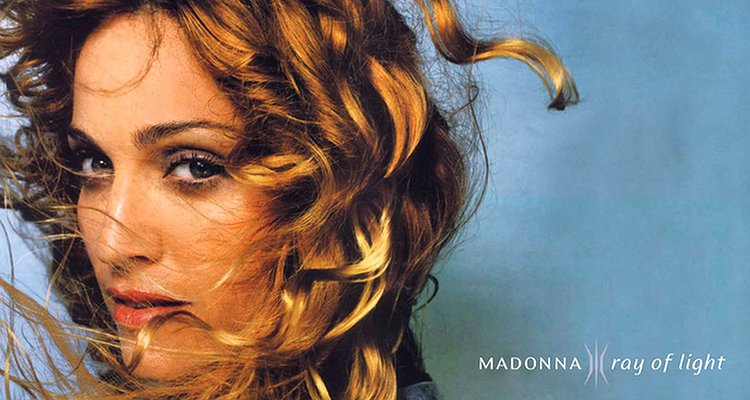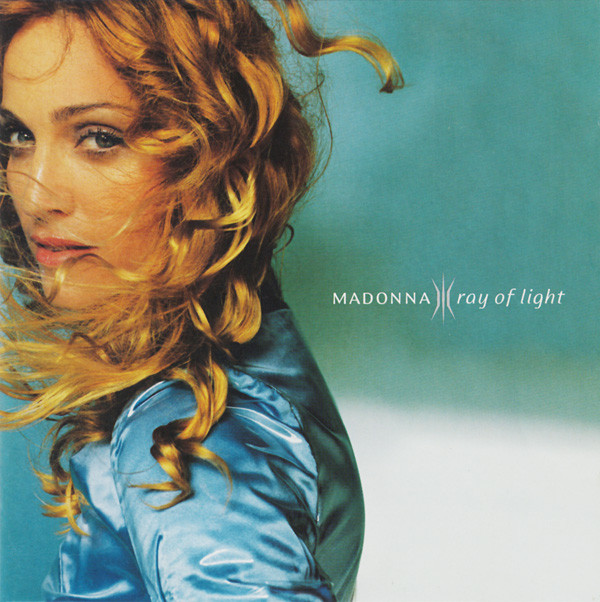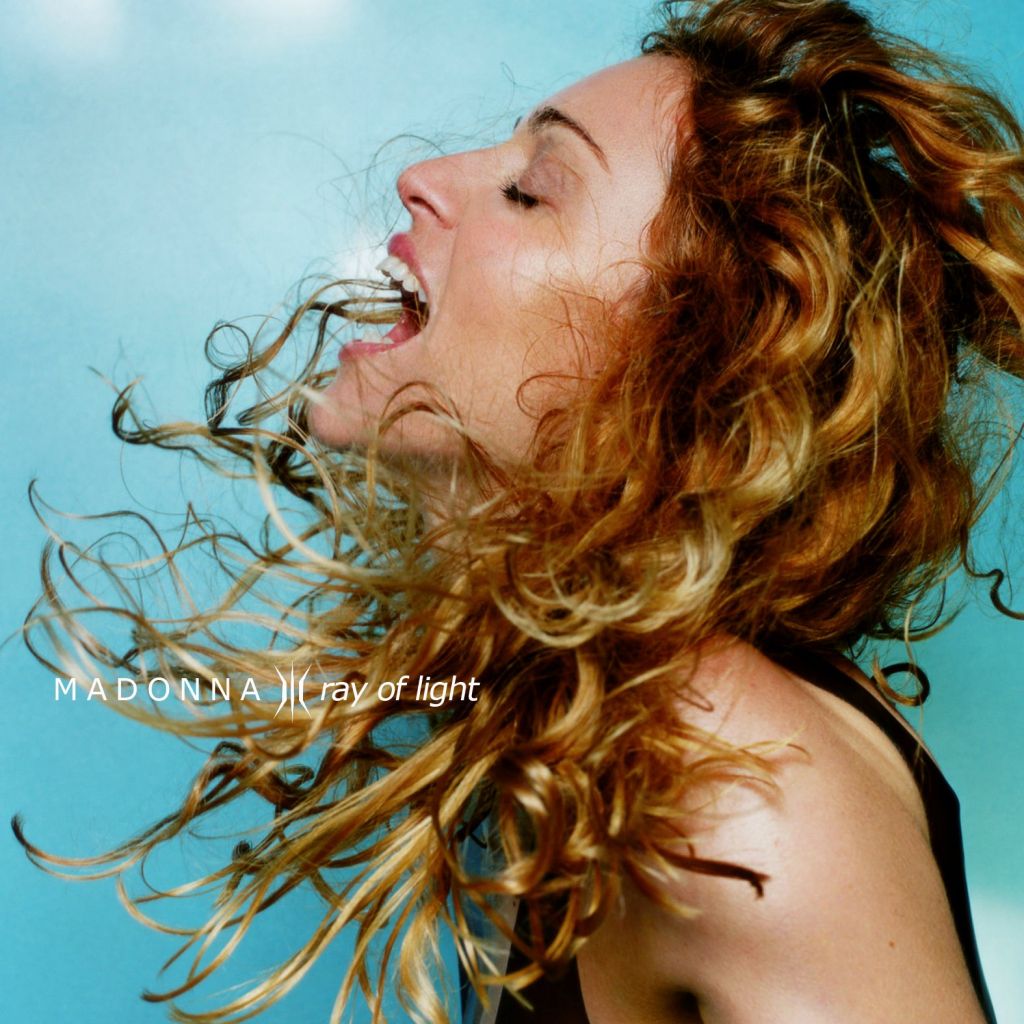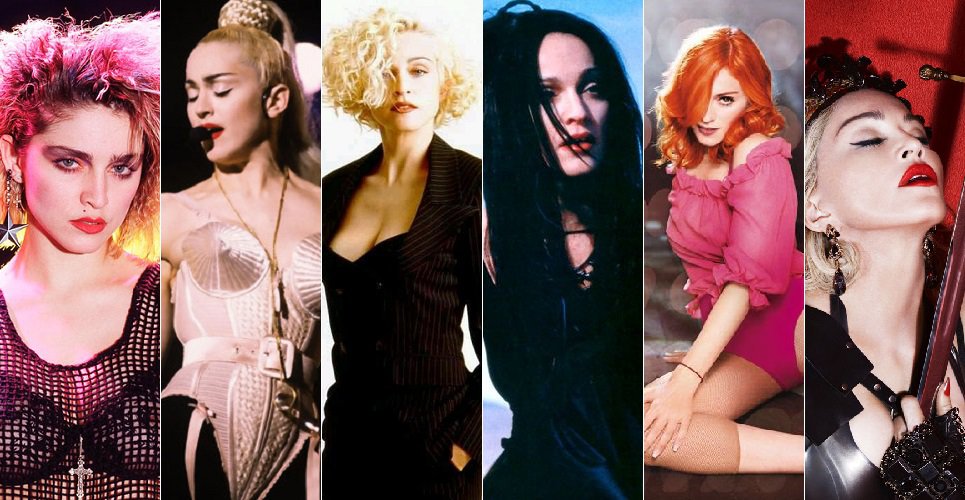Madonna’s ‘Ray of Light’ turns 20: A track-by-track review
Matthew Barton looks back at one of the Queen of Pop most career-defining records.
By Will Stroude

This article was first published in February 2018 to mark 20 years since the release of Ray of Light.
In 1997, Madonna was at a career crossroads. She had just turned in an acclaimed performance in the film version of Evita, was a new mother to daughter Lourdes… and hadn’t released a new album of original material for nearly three years.
The bold and brazen sexuality of 1992’s Erotica and its sister “coffee table” photobook, Sex, threatened to derail a career that had been in the firm ascendancy since ‘Lucky Star’ broke Madonna out of New York City’s underground dance scene in 1983.
1994’s low-key R&B LP Bedtime Stories, 1995’s ballads collection Something to Remember, and 1996’s Evita clawed back some of the credibility unfairly lost during the Erotica era by dialling down the sexual bravado, but just who was Madonna in 1997? What did she have to say? Where else was there left to turn?
It seemed that Madonna herself didn’t have the answers. That spring, she convened with Bedtime Stories collaborator Babyface again on “’Take a Bow’-ish” new material, but, abhorring repetition, scrapped the sessions.

Soon after, songwriting sessions with Rick Nowels yielded some notable fruit, but again much of the material remained unused as Madonna struggled for direction. Sessions with long-time songwriting partner Patrick Leonard, again, provided some inspiration but not the elusive sound Madonna craved.
It wasn’t until her manager Guy Oseary introduced her to British producer William Orbit that the fundamentals of what later developed into Ray of Light came into focus. Marrying her pop instincts with a fresh, original electronic drive, a painstaking four-and-a-half month recording process produced a landmark opus, not just in Madonna’s catalogue but in the landscape of modern pop music.
Released twenty years ago this month, Ray of Light changed the way electronica and EDM was interpolated into mainstream pop; the chameleonic Madonna expertly synthesised an array of influences from alternative and underground scenes and ushered in a bold new age.
Here, we look back at each of the thirteen songs that make up this classic record:
‘Drowned World/Substitute for Love’
Madonna’s audacious new sound is in evidence immediately as a soft, mid-tempo arrangement of burbling electronica, chiming guitars, and serene synth washes set a contemplative mood.
The soul-searching lyrics, where Madonna admits that she “never felt so happy” as when her “many lovers…settled for the thrill of basking in my spotlight,” are a volte-face from the bullish tone of some of her other ’90s records, and sets the tenor of introspection and reflection.
Vocally, the clear diction and rich timbre developed from her Evita vocal coaching sessions is in full flight. An aggressive bridge adds a further layer to this complex song of celebrity gone sour.
It became the album’s third UK Top 10 hit in the summer of 1998 and gave its name to Madonna’s breath-taking 2001 world tour.
‘Swim’
The oceanic imagery continues with this beautiful slice of hazy trip-hop; murmuring guitars and low-key wave effects, with some keening background vocals, provide the bed on which Madonna intones her lyric of letting go of the past, of “[washing] away all our sins.”
The water is regenerative, rather than ominous. The terrific vocal, however, is full of passion and fury and emotion – perhaps unsurprising given it was reportedly recorded on the day her friend Gianni Versace died.
‘Ray of Light’
By now, the listener has settled into the Ray of Light modus operandi – melodic guitars, synth washes, mid-tempo beauty – and the title track begins similarly…but then it storms into something else entirely, a bizarre and beautiful cacophony of sounds and styles that somehow fuses into something genuinely electrifying and life-affirming.
‘Ray of Light’ is exquisite – it’s a bit dance, a bit pop, a bit electronica, a bit folk (listen out for ‘Sepheryn’ by folk duo Curtiss Maldoon, upon which ‘Ray of Light’ was based) and a bit mad – in a good way.
Lilting guitars, peculiar bleeps, bloops, and alarms, and rippling bass frame what is surely one of the greatest vocals of Madonna’s career. She uses all of her range, power, and dexterity of tone here, screaming and growling and exultantly crying out the blissful chorus.
And that’s before we get to the impeccable video, directed by Jonas Åkerlund, which expertly immortalises in film the high-speed joyous chaos of the song. This kaleidoscope of sounds still thrills twenty years on.
‘Candy Perfume Girl’
One of the record’s most underrated songs, ‘Candy Perfume Girl’ is an unorthodox, off-kilter downbeat trip-hop experiment. Madonna’s enigmatic lead vocal and spectral harmonies, coupled with the understated programming, create a brightly-lit end-of-the-world vibe.
Madonna sings like an intangible woman in a secret Japanese discotheque, her stream-of-consciousness imagery detailing a “velvet porcelain boy” and a “fever steam girl” who “throb the oceans.”
There’s a strange fairground-esque break before the arrangement suffocates under the weight of squalling grunge guitars, walls of vocals, and heavier programming. It’s an unusual, eerie gem.
‘Skin’
Once rumoured as a potential final single from Ray of Light, ‘Skin’ finds Madonna reunited with Patrick Leonard but in a very different setting.
The superior pop songwriting partnership that brought much of 1986’s True Blue and most of 1989’s Like a Prayer is subverted into a jungle of skittering beats, jittery electronics, stop-start rhythmic pulses, and offbeat Arabic flavours. It’s dark and synth-based, and it sounds like a wild, sweaty flight through a nocturnal city.
‘Skin’ is anxious and wired, and only in the minor key chorus can you hear the classic Madonna/Leonard power ballad melancholy. This trance-like song is one of the best places to hear Orbit’s complex production work.
‘Nothing Really Matters’
‘Nothing Really Matters’ is a bit more of a traditional Madonna/Leonard composition, with a William Orbit sheen of synths and electronic gurgles for good measure.
Melodically, it’s somewhat more classic and straightforward in a traditional EDM/pop vein, and dutifully it became the album’s fifth UK Top 10 single in 1999 on the back of an iconic, sleek geisha-inspired video.
The chorus in particular has a high-energy soulful dance style, replete with backing vocals from Donna DeLory and Niki Harris, that harks back to 1990’s Blond Ambition Tour as well as the Erotica album – proving that Ray of Light isn’t an entire departure.
‘Sky Fits Heaven’
“I think I’ll follow my heart / it’s a very good place to start,” sings Madonna on this gorgeous song that fits the central Ray of Light themes of rebirth, regeneration, and self-reflection.
It’s a light, airy, spacious piece that musically is more about mood, feeling, and atmosphere; but it’s not as amorphous as it may initially seem, as it blooms into a classic chorus with a soaring Madonna/Leonard melody.
‘Shanti/Ashtangi’
If ever a song typifies Madonna’s burgeoning interest in Eastern mysticism, ‘Shanti/Ashtangi’ is it. A hypnotic melody sung in Sanskrit, it’s a splendid production job by Orbit and the unconventional treatment on Madonna’s vocal lends it an extra mesmerising vibe.
Madonna performed a version of this song at the 1998 MTV Video Music Awards with Lenny Kravitz on guitar, and legend has it that the BBC arranged for Madonna to take elocution lessons with Sanskrit scholar Vagish Shashtri to perfect her pronunciations.
‘Frozen’
This magisterial jewel was the first missive from Ray of Light in early 1998 and became Madonna’s first UK No.1 in eight years. It’s a slow-burning, soaring Madonna/Leonard ballad with a majestic, desolate string arrangement that recalls Björk’s 1997 LP Homogenic in its lush, romantic drama.
Orbit’s glacial production is suitably spine-chilling, and twenty years later it’s still a rush to recall how fresh, different, and unexpected this song was. The exquisite Chris Cunningham-helmed video, filmed in a bleak Mojave Desert, remains a high watermark of the genre.
And who can forget the iconic BBC National Lottery lip sync performance, with this enigmatic reinvention of Madonna, with henna on her hands, braids, a black corvine outfit, and wind machine? Stunning.
‘The Power of Goodbye’
The first of a trio of Madonna/Rick Nowels co-writes that appear on the album, ‘The Power of Goodbye’ is as close to pure pop as Madonna gets – an archetypal, insistent pop melody, smooth verse/chorus transitions, and a heartbreak lyric, it’s a microcosm of what Ray of Light as a whole deftly achieves – fusing modern synths and programming with guitars, strings, and striking melodies to stunning effect.
In another world, it could have been a late 90s Eurovision winner (and that is, of course, a compliment), such is its end-of-the-night power pop beauty. Extra points for the Joan Crawford beach scene reference in the dusky video.
‘To Have and Not to Hold’
This early song from the sessions is the album’s most sensual song, a hidden gem with a gently swaying, rhythmic quality. It has a shadowy, hazy Spanish feel, like a low-lit midnight alt-‘La Isla Bonita’, and wears its electronic influences subtly.
It’s an unusual sort of song for both Madonna and Nowels, and Nowels told Songwriter Universe in 2015 that “working with Madonna was a career-changing experience for me.”
‘Little Star’
Several songs on the album allude to new motherhood and the preciousness of new life, but “Little Star” is the album’s only explicit ode to Madonna’s baby daughter Lourdes.
“Having a child and questioning my own mortality and feeling incredibly responsible for someone else’s life and being aware of how much my behaviour affects her – you have to step back and realise that we all affect each other,” she told Spin in 1998.
Musically, it’s a quirky fusion of lullaby and late 90s video game music – parts of it sound uncannily like a Japanese Playstation game. But the softly emotive chorus – “God gave a present to me, made of flesh and bone…” – is an undeniably heavenly melody.
‘Mer Girl’
Ray of Light revolves around themes of regeneration, and water is a recurrent motif. ‘Mer Girl’ is the album’s most inscrutable, mysterious piece, more of a sketch than a song, as Madonna’s soft-focus vocal weaves around Orbit’s restrained production.
It’s a haunting and personal conclusion to a highly personal record. “I cursed the angels, I tasted my fears,” she sings, in one of her most poetic lyrics. Understated, and all the better for it.
‘Has to Be’ (Japan bonus track)
Subtle, serene, beautiful, compelling – ‘Has to Be’ is possibly the essence of the Madonna/William Orbit/Patrick Leonard partnership and would have been a beautiful addition to the record – but Madonna insisted on only thirteen songs, as thirteen is a lucky number in the Kabbalah.
As it is, this elegant song of quiet, dignified yearning has become a justifiable fan favourite over the years.

“I wanted it to sound old and new at the same time,” said Madonna of her intentions for Ray of Light, and it is evident that she adroitly succeeded. It wasn’t a complete transformation – indeed, bringing back Patrick Leonard proved that Madonna was keen to incorporate her past into her present – but the pervading influence of Ray of Light on modern pop, by virtue of its freshness, cannot be understated.
Her long-standing reputation as a master of reinvention, a magpie collecting disparate sounds and styles and collating them and presenting them in an inventive new way, largely stems from her restless and courageous experimentation on this record.
At heart, the blissful, shimmering pop melodies were always what Madonna had done best anyway, but never had she utilised electronic production in such an integral way. Ray of Light also re-contextualises the rest of Madonna’s catalogue, and brings the significance of Erotica and Bedtime Stories into sharp focus.
What were once derided in some quarters as sub-par, wrong turns, unedifying missteps are now celebrated as beacons of pop individuality and experimentation, of brave choices, of daring risks taken in the face of public consternation.

The interest in electronic dance production and subversive genre experiments makes more sense to both the Madonna and casual music fan with Ray of Light’s pot of gold at the end of the rainbow, but it also highlights the strength and core vision Madonna had always proudly adhered to.
The Madonna of the mid-1980s – the exuberant Madonna of ‘Like a Virgin’ and ‘Material Girl’ – subtly shifted, at 27, into the pop behemoth of True Blue, a status cemented by the artistic magnum opus of Like a Prayer where, for largely the first time, her critical stock matched her commercial fervour.
By the time of Erotica, Madonna had earned enough stripes to experiment but was roundly ridiculed, and in some cases reviled, for doing so. Ray of Light is the sound of a survivor, a pop maverick coming out the other side of a period in the wilderness at 39 with a perfect marriage of titanic pop smarts and alt-pop experimentation. It’s arguably a twin peak in her catalogue along with ‘Like a Prayer’, and enabled Madonna to continue her pursuit of pop innovation through the next phase of her career.
It is debatable whether Madonna has, or will, scale the artistic heights of this era again, but regardless – 20 years later, Ray of Light still sounds as fresh, assured, bold, and beautiful as ever.
